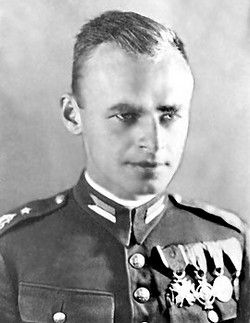World War Two Declaration Anniversary: Witold Pilecki, The Spy Who Volunteered for Auschwitz

On 19 September 1940, Witold Pilecki, a Polish soldier, went outside during a street round-up in Warsaw to be captured. Along with around 2,000 civilians, Pilecki was taken to Auschwitz, where he was assigned the inmate number 4859. He had volunteered for a secret undercover mission: to get inside the camp, gather intelligence and report back to the Allies.
Under the pseudonym Tomasz Serafinski, he arrived at the camp between 21 and 22 September and saw Auschwitz for the first time.
"We were struck over the head not only by SS rifle butts, but by something far greater," he wrote. "Our concepts of law and order and of what was normal, all those ideas to which we had become accustomed on this Earth, were given a brutal kicking."
Pilecki's clandestine intelligence, received by the Allies in 1941, was among the earliest describing the appalling conditions of the Nazi death camp. His work, published into English for the first time in 2012, stands among the few diaries of camp inmates, alongside the works of literature and memory by Primo Levi and Elie Wiesel.
World War Two and Polish Secret Army
Pilecki was born on 13 May 1901 in Karelia, Russia, where his family had been forcibly resettled by Imperial Russian authorities after the Poland's January Uprising of 1863 and 1864 was suppressed.

Just before the outbreak of the Second World War, Pilecki was mobilised as a cavalry-platoon commander and assigned to the 19<sup>th Infantry Division – part of the Polish Army Prusy.
After his platoon moved towards Lwów, modern-day Lviv, in Ukraine, they disbanded after eastern Poland was annexed by the Soviet Union. Pilecki returned to Warsaw with his commander, Major Włodarkiewicz.
On 9 November 1939, the two men founded the Secret Polish Army, Tajna Armia Polska, one of the first underground organisations in Poland.
As the resistance movement grew, Pilecki became the organisational commander of the group. By 1940, the organisation had around 8,000 men – over half of which were armed – across Warsaw, Lublin and other Polish cities. It became part of the Home Army in 1941.
Auschwitz
In 1940, Pilecki presented a plan to his superiors – to enter Auschwitz and gather intelligence. Little had been known about the camp at the time, and it was thought to be an internment camp or large prison.
At Auschwitz, while working in various commandos and surviving pneumonia, he organised an underground Union of Military Organisations to improve morale, provide news from the outside, distribute extra food and set up intelligence networks. He witnessed at first hand, what was happening inside the camp.
Soviet prisoners of war were the victims of the first gassing by Zyklon B, which was made up of poisonous hydrogen cyanide, later used to murder the Jews in 1942. At the time, Pilecki was fortunate enough to be on a work assignment beyond the gates of the camp.
"The men had been so tightly packed that even in death they could not fall over," Pilecki wrote of the murdered inmates.

The organisation provided the Polish underground with information about the camp from October 1940 – just weeks after Pilecki arrived.
His reports were forwarded to the British government and in 1942, his resistance movement broadcasted information on the number of arrivals, deaths and the conditions inside Auschwitz.
Escape
Pilecki's reports, later known as Witold's Report, were a main source of intelligence on Auschwitz for the Western Allies. While he hoped the Allies would drop arms or troops into the camp or that the Home Army would organise an assault, the Gestapo began to seek and kill the resistance's members.
On the night of 26 April 1943, Pilecki decided to escape. Assigned to a night shift at a camp bakery outside of the perimeter fence, he and two comrades overpowered a guard, cut the phone line and left – taking with them documents stolen from the SS.
Months later, Pilecki fought in the Warsaw Uprising, after it broke out on 1 August 1944. As officers fell, it was reported, he disclosed his true identity. He spent the rest of the war in German prisoner-of-war camps at Łambinowice and Murnau, before being arrested by the Ministry of Public Security in May 1947. After a show trial, he was executed one year later, on 25 May 1948.
Pilecki's report on his undercover mission at Auschwitz, hailed by The New York Times as "a historical document of the greatest importance", was published in English under the title The Auschwitz Volunteer: Beyond Bravery.
© Copyright IBTimes 2025. All rights reserved.






















